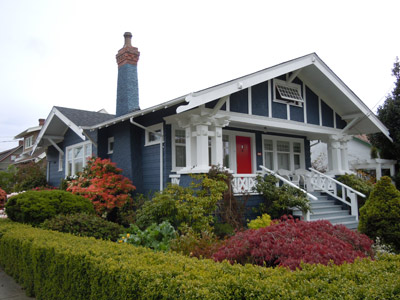Heritage Register
Gonzales
271 Beechwood Avenue
Built
1913
Heritage-Designated 2012
Architect: Elmer Ellsworth Green
Builder: Bungalow Construction Company

ARCHITECTURE:
This beautifully-preserved cottage is a classic example of the California Craftsman Bungalow. The style, so named because it showcased the method of construction and the carpenter’s skills, is dominated by its full-width, recessed front porch, with huge roof overhangs and complex stickwork.
The intricacy of the interlaced woodwork is increased by coups d’oeil --
numerous pyramidal wooden blocks are applied to imitate beam ends, while rafter-tails are scroll-sawn into fantastical shapes.Tapered piers on both front corners lead up to the clustered assemblages of three columns, and are echoed by a dramatically tapered chimney on the left side. Both piers and chimney are finished in an unusually coarse stucco, while the house itself is sheathed in shingles with alternating wide and narrow coursing.
Other California/Craftsman Bungalow elements include the low-pitched roof with front-facing gable, exposed rafters, triangular knee braces under gables, and gabled box bays. Typical Craftsman fenestration includes a 21-light awning window in the gable, multi-pane-over-one sash windows or with one large central pane on the porch and in the bays, and piano windows bracketing the chimney.
The California firm of Charles Greene and Henry Greene virtually created the California Craftsman archetype, in the first decade of the 20th Century. This widely influenced Pacific Coast design, particularly the Seattle firm of Elmer Ellsworth Green (no relation). While this is not as imposing as the grandest houses of this style (mostly in California, but see 1961 Fairfield, Pl, Gonzales), it is easily among the best examples of E. E. Green’s work in Victoria. Other examples are clustered at Carnsew, Durban and Kipling Streets. This home has much in common with the slightly larger 162 Robertson St (Gonzales) by Green. While the grander houses were built for the significant sum of $7-10,000, these smaller single-storey bungalows, with five or six rooms, typically cost $2,000-$3,000. This one, built on spec in 1913, cost just $1,900.
The Bungalow Construction Co. was one of Victoria’s most prominent pre-WWI speculative housing companies. They employed several architects, however the majority of their houses were designed by E.E. Green.
ORIGINAL OCCUPANTS:
This house was purchased by Bertie Livingstone (b. Fuzhou, China 1876) and May Edna (née Turner, b. Sacramento, CA, 1879-1941) Robertson. Bertie Robertson was the son of Captain Horatio Robertson and Wilhelmina Livingstone who had 8 children, most of which were born in China. In 1888 the family came to Canada and purchased Moresby Island, near Sidney, where they built a large unusual house and started farming. Bertie was working in Victoria as an accountant when he married May in 1912. By 1920 Bertie was the Secretary Treasurer of the Harbour Marine Company. In 1922 the Robertsons moved across the street to 270 Beechwood where they remained until about 1934.
OTHER OCCUPANTS:
Subsequent occupants included Walter Gaskill in 1924, a musician at the Royal Vic Theatre, and Ernest F. Marshall 1926-1929, City freight and passenger agent for the Chicago, Milwaukee and St Paul Railway. The house had a high turnover of residents between 1930 and 1942.
From 1942 to at least 1951, widower James W. Barr owned the house. He was employed at Victoria Machinery Depot and later as engineer for the Central Building.

